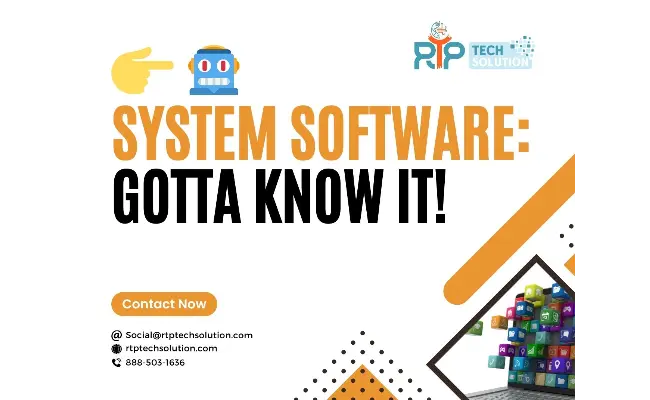Beneath the surface of our day-to-day digital interactions lies a complex network of functionalities, an interplay between system software and application software. In the grand tale of software programs, the protagonist is often unsung – the system software. This powerful hero silently enables our digital capabilities, functioning as the universal translator that bridges the gap between the user, the computer, and the myriad applications that run on it.
The Artful Diplomacy of System Software: Uniting Diverse Operating Systems
System software is the invisible tapestry weaving together the different components of a computer system, a harmonious orchestra where each instrument plays a vital role. At the heart of this orchestra is the operating system (OS), an integral part of the system software, which acts as the conductor, ensuring smooth coordination among the various players.
In the international theater of operating systems, the OS operates akin to a skilled diplomat, adeptly navigating diverse operating systems, whether it’s the omnipresent Microsoft Windows, the open-source Linux, the exclusive MacOS X, or the versatile BSD. Its key role is to establish seamless compatibility and efficient communication across a spectrum of platforms, from personal computers to mobile devices. This harmonious communication is essential in our interconnected digital world where versatility and interoperability are of paramount importance.
Unraveling the DNA of System Software: Decoding its Core Characteristics
The system software can be best defined by its four inherent characteristics – speed, versatility, security, and proximity to the computer hardware. Akin to the human DNA, these characteristics determine the functioning and performance of the system software.
As the manager of the computer’s resources, system software expertly handles the central processing unit (CPU), memory, and peripheral devices. It ensures peak performance by multitasking, maintains a robust security system, and interfaces closely with the computer’s hardware. Like the DNA is to a human, system software is integral to a computer system, often coming pre-installed, ready to govern the machine’s operations from the moment it powers on.
Diving into the Components of System Software: A Close Examination
System software is not a monolith but rather a consortium of various components, each with a specific purpose and function. These components include the operating system software, device drivers, middleware, utilities, and programming language interpreters.
At the center of this consortium is the operating system, the maestro directing a complex symphony of tasks within the computer system. The operating system manages memory, software, hardware, and ongoing processes, ensuring a harmonious operation.
Device drivers, on the other hand, facilitate communication between the computer and its peripheral devices, such as printers, scanners, and keyboards. Middleware promotes interoperability among software components, and utilities aid in maintaining and optimizing the system. Lastly, programming language interpreters translate high-level programming language code into machine code, enabling the computer to comprehend and execute these commands.
The Operating System
An operating system is to a computer what a backbone is to a human body – central, supportive, and essential for efficient functioning. It manages the system’s resources effectively and presents a user-friendly interface for application software to run.
Today, an array of operating systems include- Microsoft Windows, macOS, and Linux are some of the popular choices for personal computers, while Android and iOS dominate the mobile operating system market.
An operating system’s role is broad, encompassing memory management, device management, and task scheduling. It ensures the smooth running of software and applications, handles resource allocation, and provides a user-friendly interface between the user and the computer hardware.
The Role of Application Software
If system software is the backbone, then application software is the craftsman’s tool, designed for a specific purpose – assisting the user in executing various tasks. From drafting documents and managing spreadsheets to editing photographs and creating presentations, application software equips the user with the tools needed to perform these tasks.
While system software forms the robust infrastructure of a computer system, application software adds functionality, giving users the means to perform tasks and create content. Every application, be it the graphical design suite on a personal computer or a weather app on a mobile device, relies on the underlying operating system and system software to function efficiently.
Prominent Types of Operating Systems
Microsoft Windows, with its user-friendly interface and wide compatibility with numerous software and applications, remains the most popular operating system worldwide. Apple’s macOS and iOS for desktop computers and mobile devices, respectively, hold significant positions in the market. In the realm of mobile operating systems, Android, designed for touchscreen mobile devices, enjoys considerable popularity.
The Emergence and Evolution of Real-Time Operating Systems
Real-Time Operating Systems (RTOS) represent a specialized segment in the wide array of operating systems. Designed to process data in real-time, without buffer delays, RTOS finds its applications in mission-critical systems. These systems, such as medical equipment, airplane controls, or complex robotics, demand immediate processing and reaction, where even a slight delay could lead to catastrophic outcomes.
The Dance of System and Application Software
Peeling back the layers of our digital tools, we uncover an intricate ballet between system software and application software. System software sets the stage, laying down the essential groundwork for the operation of a computer system. At this stage, the application software performs, executing specific tasks demanded by the user through a set of instructions. This harmonious dance, orchestrated by software developers and experienced by end-users, forms the bedrock of our interactions with digital devices.
So, as we glide through our digital lives, effortlessly typing away at our personal computers or swiping through apps on our mobile devices, let’s tip our hats to the true puppeteer of this performance, the system software. Like a seasoned director behind the scenes of a blockbuster show, it continues its tireless efforts, often invisible but always vital.
You know, it’s sort of like that friend who always has the best advice but never hogs the limelight, right? System software’s your reliable buddy, always making sure everything runs like clockwork, while you and the flashy application software take center stage.
And just like any good friend, your system software needs to be in the best shape to keep your digital life humming along. If you need help with that, the experts at RTP Tech Solution are always here to lend a hand. From troubleshooting your operating system woes to optimizing your system software, RTP Tech Solution has got your back.




